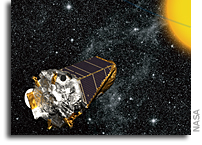Planet Bonanza Hints of Worlds Similar to Our Own

For planet hunters, this has been a bountiful year. A team lead of astronomers at the SETI Institute and NASA Ames Research Center have used data from NASA’s Kepler space telescope to uncover 715 new exoplanets.
The newly-verified objects orbit 305 different stars, and therefore include multi-world systems that are reminiscent of the Sun’s own planetary family. The announcement of these discoveries was followed by news that Kepler had also found the first Earth-size planet in the habitable zone of its star, Kepler 186f. This is a significant milestone in the task of determining the prevalence of terrestrial planets in the Milky Way galaxy.
“These results are showing us that not only are Earth-sized planets common, but so are multi-planet systems containing potentially habitable worlds,” notes Jason Rowe, a SETI Institute astronomer who co-led the study. “Most of the new planets orbit their host star much closer than Mercury, but a few are beginning to bear a similarity to our own solar system.”
The deluge of new planets has been intensified by a new analysis scheme called verification by multiplicity. This technique can be applied to many planets at once, allowing the researchers to verify hundreds of new planetary systems in wholesale fashion, rather than teasing them from the Kepler data one-by-one as done in the past. The new technique uses probability arguments based on the recognition that, of the 150,000 stars observed by Kepler, hundreds were found that have multiple planet candidates. On this basis, the researchers are assured that their results are not distorted by binary stars that can mimic a multi-world system. The new discoveries increase the total number of known exoplanets to over 1,700.
“From this work we’ve also learned that planets in these multiple systems are small, and their orbits are flat and circular, much like our own solar system,” Rowe said.
On April 17th, the Kepler team announced the discovery of Kepler 186f, the first Earth-sized planet found in the habitable zone of its host star, marking a major milestone in determining the frequency of Earth-like planets in the Milky Way galaxy.
“Uncovering these worlds and showing that habitable worlds could be very common has increased the likelihood that there is life — perhaps abundant life — elsewhere in the cosmos,” notes David Black, President and CEO of the SETI Institute.
Data collection from the Kepler mission ended in the spring of last year, due to the failure of a second on-board reaction wheel, essential to accurate pointing of the telescope. However, on May 20th, NASA announced the approval of the K2 mission, intended to repurpose Kepler to use the pressure of sunlight hitting the side of the spacecraft to act as a third wheel.
“We can’t continue to look at the original Kepler star field,” said Douglas Caldwell, Kepler Instrument Scientist at the SETI Institute, “but spacecraft are built and operated by very smart people, and thanks to the hard work of the entire Kepler team we can now search for planets in a wide variety of environments and conditions, including star forming regions. Doing so will teach us more about how our own planetary system formed and evolved.”
“The more we explore the more we find worlds among the stars that remind us of home,” Rowe notes.
Media Contacts:
Seth Shostak
SETI Institute
[email protected]
+1 650 960-4530
Leslie Sage
CASCA Press Officer
[email protected]
+1 301 675 8957
Science Contacts:
Jason Rowe
SETI Institute
[email protected]
+1 650 276-9092
Douglas Caldwell
SETI Institute
[email protected]
+1 408 857-4353
Jason Rowe is presenting these results at this week’s annual meeting of the Canadian Astronomical Society (CASCA) in Quebec [http://casca2014.craq-astro.ca/index_en.php].
The Canadian Astronomical Society (http://casca.ca) is devoted to the promotion and advancement of knowledge of the universe through research and education. Membership is open to persons with a professional involvement with these goals in astronomy and the related sciences. The main activities of the Society are its annual scientific meetings, the planning and realization of scientific projects, the support of the scientific activities of its members, and the dissemination of related information among members and other interested persons.
The mission of the SETI Institute (http://www.seti.org) is to explore, understand and explain the origin, nature and prevalence of life in the universe. The Institute is a private, nonprofit organization dedicated to scientific research, education and public outreach. It comprises three centers, the Center for SETI Research, the Carl Sagan Center for the Study of Life in the universe and the Center for Education and Public Outreach. Founded in November 1984, the SETI Institute today employs over 150 scientists, educators and support staff.








